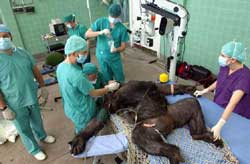
Results of a UK study in this week’s issue of THE LANCET suggest that the antianginal drug nicorandil could reduce the risk of cardiovascular disease associated with angina.
Angina occurs in 10% of men aged older than 60 years in the UK (10-15 years later in women), and is a common underlying cause of coronary heart disease (CHD). Aspirin, angiotensin-converting-enzyme (ACE) inhibitors, and statins reduce the risk of cardiovascular events in subgroups of patients with stable angina; however,

The first public release of plant gene chip information is being launched at the Society for Experimental Biology conference in Swansea on Friday 12th April. Scientists from the Nottingham Arabidopsis Stock Centre (NASC), part of a multi-million pound resource network, will announce a newly accessible plant gene chip database which is available through the internet.
Unlike in GATTACA, where a drop of Ethan Hawke`s blood or an eyelash could tell you what genes he had, gene chips can tell you

Romina, a female Western lowland gorilla at Bristol Zoo Gardens, has successfully undergone pioneering surgery to restore her sight in the first ever cataract operation performed in Europe on an adult gorilla. Born with cataracts, 21-year-old Romina underwent the two-hour procedure at the University of Bristol`s Veterinary Hospital in March and, for the first time in her life, she can now see the world around her clearly.
Romina was born at Rome Zoo and hand-reared. Before her arrival in the UK

The phrase “king of the jungle” invariably conjures up the image of a majestic, tawny cat with a fluffy mane framing its face. But in fact not all male lions have big hair. In Kenya’s Tsavo National Park–famed for the man-eating lions that reportedly terrorized railroad workers there in the late 1800s–a number of males lack manes altogether. Exactly why this should be the case–or why any lions should have manes, for that matter–has been difficult to explain. To that end, the results of a new

New count doubles the rocks in asteroid belt.
There are twice as many asteroids between Mars and Jupiter as previously believed, according to the latest study. But the probability of a stray one colliding with Earth remains negligible.
Edward Tedesco of US research company TerraSystems Inc.and Francois-Xavier Désert of the Astrophysical Laboratory in Grenoble, France, found that there are between 1.1 million and 1.9 million asteroids swarming round the ’main asteroid belt’1.

An unprecedented source of planetary nebulae, the disk-like relics of elderly, dying stars, has been discovered in the southern part of our Milky Way galaxy.
With about 1000 planetary nebulae found so far and many more still to be discovered, the number of aged stars in their death throes revealed by the new survey is rapidly overtaking the entire population discovered over the entire sky during the last 75 years.
The cosmic graveyard is revealed in deep survey images taken in ‘H-a

– new calculation confirms standard model of particle physics. Contribution of hadronic vacuum polarization determined with unprecedented accuracy. The magnetic moment of the muon is an important precision parameter for…
Technique may prevent formation of unwanted waves that siphon off needed energy. Heating plasma to the ultra-high temperatures needed for fusion reactions requires more than turning the dial on a…

An international team of astronomers, led by researchers from the Astronomical Observatory of the University of Warsaw, have identified a new class of cosmic X-ray sources. The findings have been…

Antibody that Neutralizes Inhibitory Factors Involved in Nerve Regeneration Leads to Enhanced Motor Function after Acute Spinal Cord Injury. Researchers at 13 clinics in Germany, Switzerland, the Czech Republic and…

How the body’s natural killer cells could fight leukemia. Every year, some 13,000 people in Germany are diagnosed with leukemia. Despite intensive chemotherapy, around one in two of them die….

… eco-friendly reactor converts air and water into ammonia. Producing enough ammonia to feed the world comes with a large carbon footprint;. process described in new UB-led study could help…

How simulations help manufacturing of modern displays. Modern materials must be recyclable and sustainable. Consumer electronics is no exception, with organic light-emitting diodes (OLEDs) taking over modern televisions and portable…

“Neurons that fire together, wire together” describes the neural plasticity seen in human brains, but neurons grown in a dish don’t seem to follow these rules. Neurons that are cultured…

The quest for sustainable energy solutions has been a major focus of scientific research for decades. Solar energy, a clean and renewable source, has emerged as a promising alternative to…

With a processing speed a billion times faster than nature, chip-based laser neuron could help advance AI tasks such as pattern recognition and sequence prediction. Researchers have developed a laser-based…

New technology could remotely identify various types of plastics, offering a valuable tool for future monitoring and analysis of oceanic plastic pollution. Researchers have developed a new hyperspectral Raman imaging…

Artificial Intelligence (AI) has established a strong presence across industries, large and small. The “VoBaKI” research project has empowered small and medium-sized enterprises (SMEs) with an innovative tool to independently…